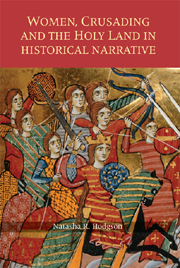5 - Wives
from PART II
Published online by Cambridge University Press: 12 September 2012
Summary
Wives and Medieval Society
MARRIAGE has always played a prominent role in the formation of social bonds in western Europe, from Antiquity to the present day. In medieval society it usually involved a financial and legal transaction which enabled a new economic unit to provide for the propagation of the family line, but it also had links with the ‘mysterious and terrifying world of sexuality and procreation – in other words, the realm of the sacred’. During the medieval period the Church took increasing control over marriage as a sacred institution and attempted to regulate it through ecclesiastical courts, but old secular customs, Roman, Germanic, or tribal, were still prevalent in practice. From the eleventh century onwards, there was increasingly rigid legislation not only over marriage, but also over the sexual act itself. In order to understand the potential effects of crusade and settlement on perceptions of wives in medieval narratives, traditional and contemporary ideas about marriage, sex, property and influence must be considered.
Marriage: Tradition and the Reform Papacy
Celibacy and continence were traits admired by the early Christian theologians, but marriage was a sacrament, and arguments in its favour did not just follow the Pauline view that it was the lesser of two evils. In the Bible, woman was created to be man's helpmeet, and this sacrosanct relationship had existed from the beginning of Creation. This idea formed the cornerstone of the argument in favour of adhering to a wife's advice – as long as she counselled temperance and mercy.
- Type
- Chapter
- Information
- Women, Crusading and the Holy Land in Historical Narrative , pp. 103 - 153Publisher: Boydell & BrewerPrint publication year: 2007



